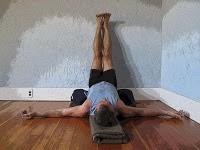 Last week, I shared with you a dynamic sequence for Cardiovascular Health. This week, I’d like to focus on the inverted yoga poses that can have some beneficial effects on overall heart health. Inverted poses come in different shapes and sizes; some are full inversions, such as supported Legs Up the Wall pose (Viparita Karani), while others are partial inversions, such as Downward-Facing Dog pose, in which your body is inverted from your hips to your head but your legs are in their normal relationship to gravity.
Last week, I shared with you a dynamic sequence for Cardiovascular Health. This week, I’d like to focus on the inverted yoga poses that can have some beneficial effects on overall heart health. Inverted poses come in different shapes and sizes; some are full inversions, such as supported Legs Up the Wall pose (Viparita Karani), while others are partial inversions, such as Downward-Facing Dog pose, in which your body is inverted from your hips to your head but your legs are in their normal relationship to gravity.Inversions can have several immediate and long-term influences on your heart and circulatory system. If an inversion is physically challenging or held for a long time with lots of muscular effort involved, such as a three-minute Downward-Facing Dog pose, this can have a stimulating effect on your heart, increasing the heart’s workload and essentially exercising the heart muscle more than when it is resting. Inversions can also assist in the return of the blood in the your veins back to your heart. The veins rely on the back pressure of blood coming out of the capillaries (which may not be particularly strong), the muscle tone in the walls of the veins (which is much less then an arteries), and one-way valves inside the veins that encourage blood to move toward the heart and not backflow towards the gravity-dependent parts of your legs and arms. As we get older, some of those valves fail and stop working properly, which can result in varicose veins. Regular exercises, such as yoga and even walking, help somewhat by contracting and relaxing the skeletal muscles of the extremities to create a kind of pumping action on your veins to keep the blood moving in the right direction. Inversions put your body in a position to take advantage of gravity to assist in venous return to your heart—you flip upside down and gravity pulls the blood back toward your heart and head!
Inversions can also have a quieting effect on your nervous system, encouraging a shift from Fight or Flight mode to Rest and Digest mode. This feeds back to your cardiovascular system, allowing it to quiet and rest by lowering your blood pressure, slowing your heart rate and promoting good variability in your heart rhythm moment by moment. This quieting effect occurs when inversions are done with less effort and held for longer periods of time, such as Legs Up the Wall pose practiced for 5-10 minutes. We have written about the baroreceptors in the neck and heart before, so if you want to bone up on how inversions affect the heart system, check out Why You Should Love Your Baroreceptors. As I am pretty sure I have said before, your heart muscle needs both exercise and rest, so a good combination of effort and relaxation in your practice will give your heart a more balanced experience.
If you have a new diagnosis of high blood pressure, especially if it is not yet under good control, or already have developed some form of heart disease, this practice is likely not for you. Having said that, there are exceptions to this caution, in particular if you are working with an experienced teacher who knows your health history and can guide you into inversions gradually.
And for additional ideas on supported inversions, check out Nina’s post from a while back: All About Supported Inversions.
Inverted Heart Health Practice:1. Reclined Leg Stretch 1 (Supta Padangustasana1): Although we often think of this pose for opening your hips and hamstrings, it is a partial inversion, so I thought it a good place to start today! We will stick to version 1 only today, as it involves keeping the top leg more vertical.
Lying on your back, bring one knee into your chest and place the strap around the arch of your right foot. Extend your leg towards vertical (getting vertical depends on your unique muscle and joint challenges). Push out along the line of your leg bones towards your heels, and pull back towards your hip via the strap. Gradually work your towards 90 seconds in the pose. Repeat on the other side. 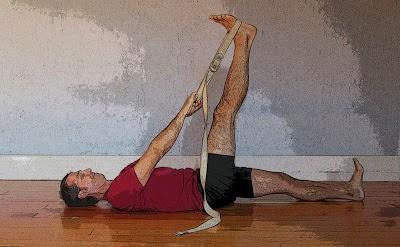
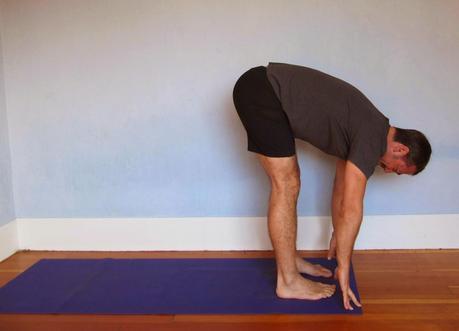
The supported version of this pose, where you rest your head on a chair, a block, or the floor, can be more quieting to the heart and nervous system, so try that if your flexibility allows.
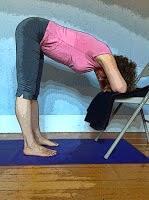
4. Downward-Facing Dog Pose (Adho Muka Svanasana): Come down to hands and knees, turn your toes under and lift up into Downward-Facing Dog pose. If you are feeling tight, take the first couple of breaths to move a bit in the pose to release tension and prepare to hold the pose in a quieter way. Once you become more still in the pose, you again will need to decide whether to stay for a shorter or longer period of time.


Active and Supported Bridge Pose (Setu Bandha): Come into Constructive Rest position (on your back with knees bent and heels about four inches from your hips), and establish the normal, slightly arched shape of your lumbar spine. Then lift your hips straight up as you push down into your feet, like an elevator going up a few floors, maintaining the neutral arch of the lower back. Once in Bridge pose, bring some focus to your arms. Press the upper back of your upper arms (right where your arms meets your shoulders) firmly down into the floor while actively lifting the lower tip of your breast bone up to the sky.
In the full, active Bridge Pose, you are essentially inverted from your knees to your head. Stay for 15-30 seconds. To come down, lower your hips straight down, like an elevator returning to the lobby floor. Rest for a moment and consider repeating one more time. Then, come up again and place a block under your hips at the height that feels best for you. Since you will be allowing your pelvis to rest on the block, this version of bridge in much more restorative in quality, so you could easily hang out in for a while, possibly for several minutes.
Another alternative is one of Nina’s favorites, Supported Bridge pose with Straight Legs.
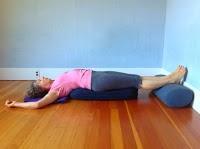
Legs Up the Wall (Vipariti Karani): See Featured Pose: Legs Up the Wall Pose for instructions. If your body permits it, try to use one or two blankets under your pelvis, or, even more effective, a bolster. This will support more of your body in the inverted position. If you set yourself up well, this pose is usually easy to hang out in for anywhere from 5-20 minutes.
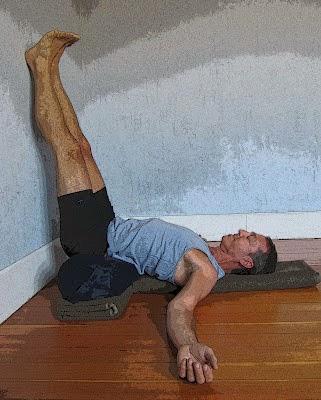
Corpse Pose (Savasana) of your choice: See Corpse Pose Variations for options. I will sometimes end my practice with Legs Up the Wall pose, but there is something to be said for doing the inversion-neutral Corpse Pose, where you are neither upright or upside down. So take 5 to 10 minutes to rest or ready yourself for what follows in your day. I’d recommend bringing your attention to the heart area of your chest as you also keep some of your awareness on the easy flow of your breath.


